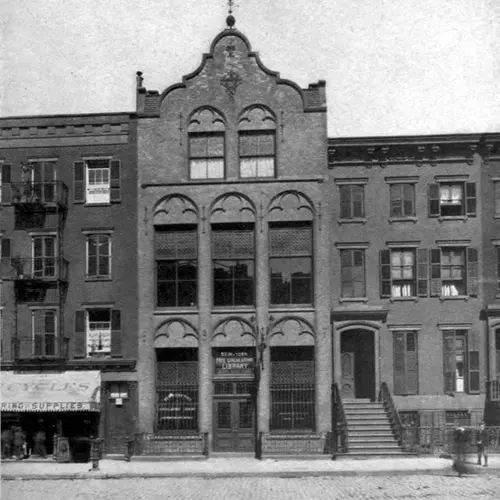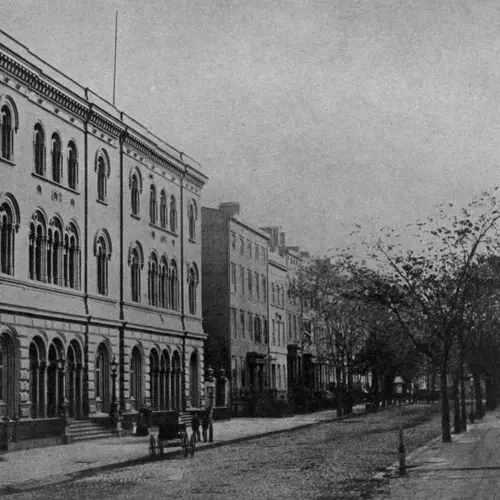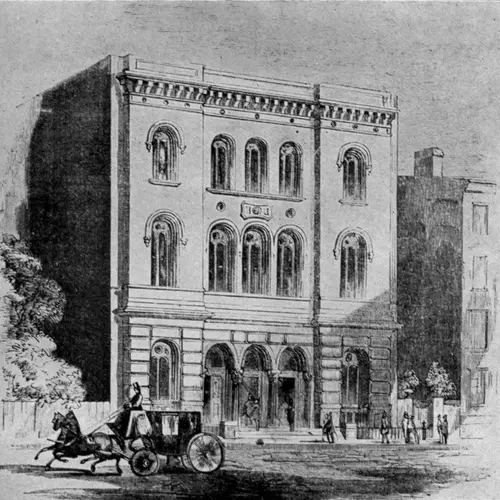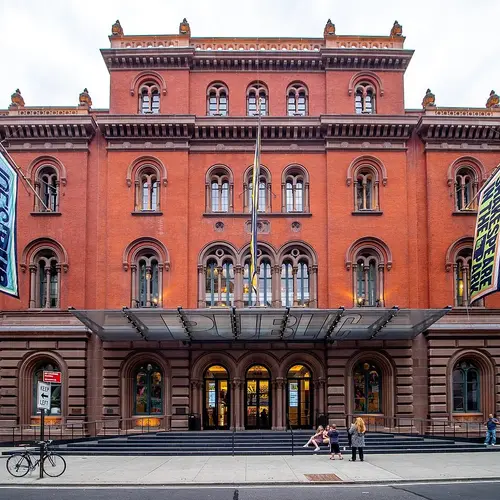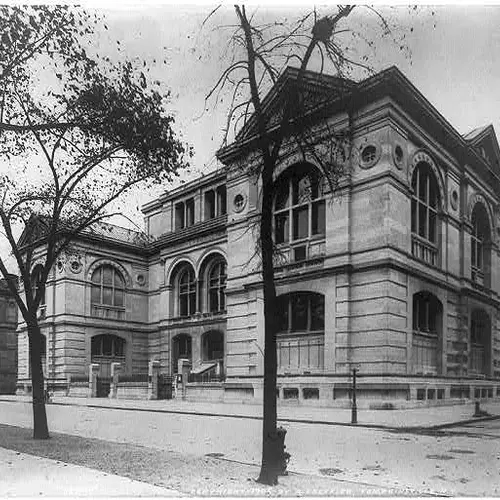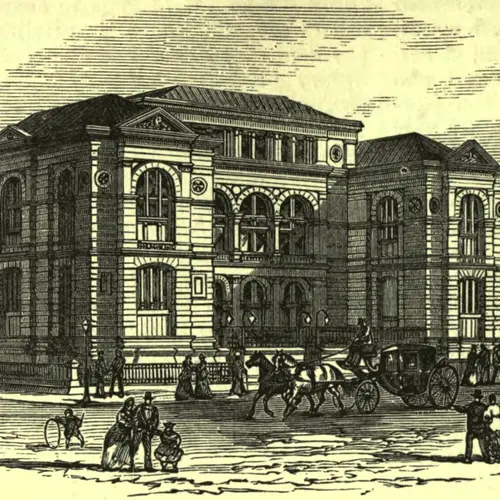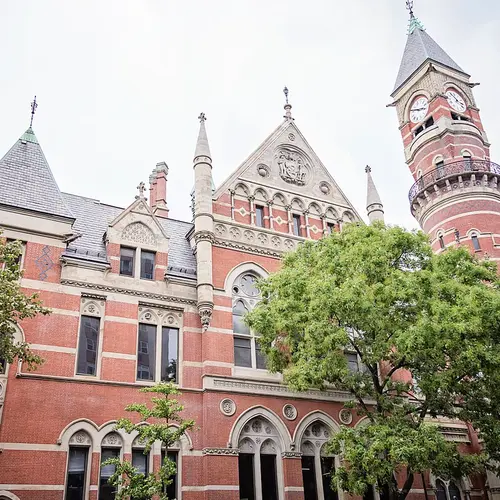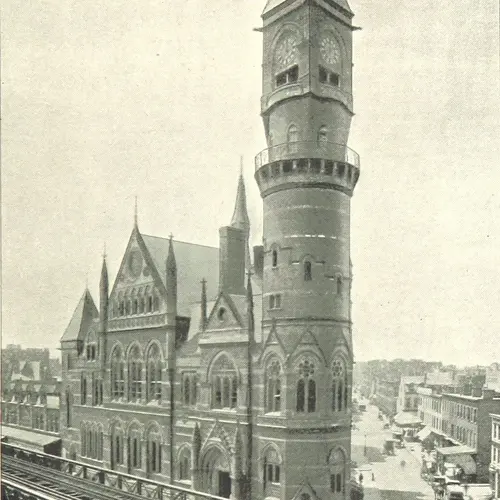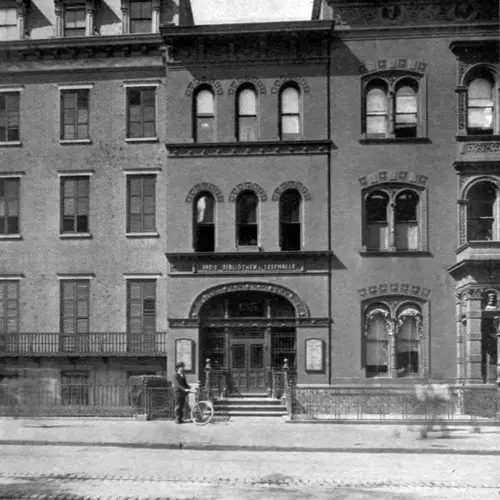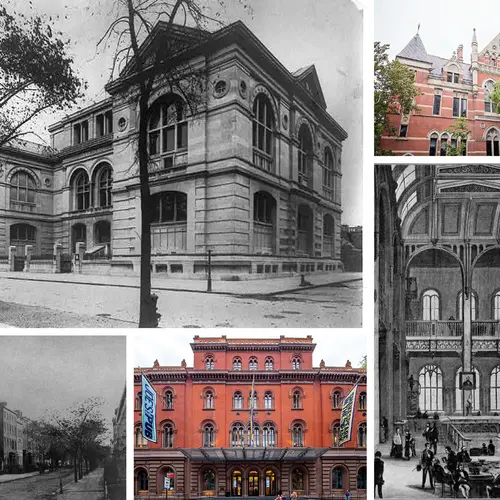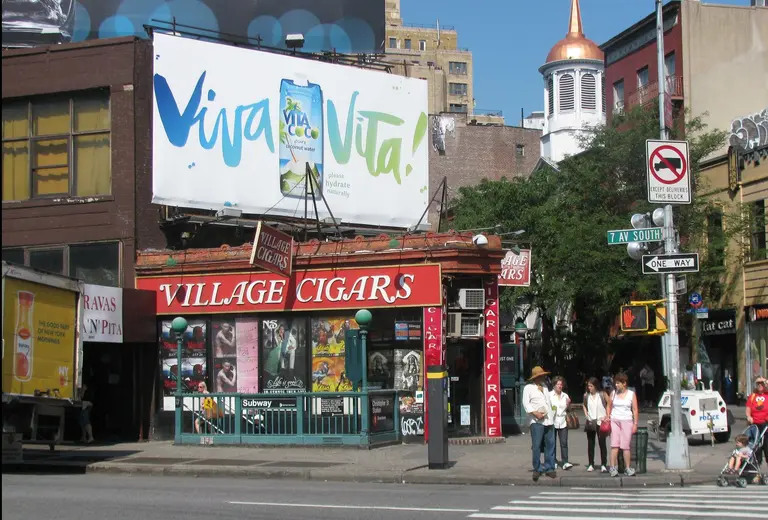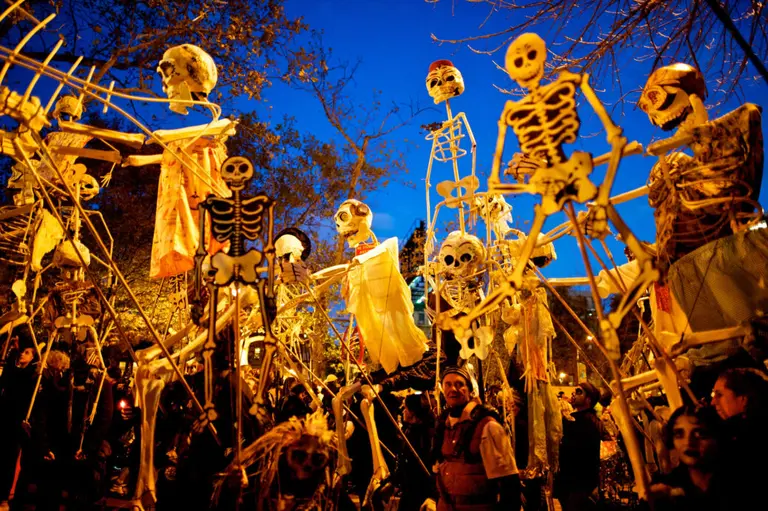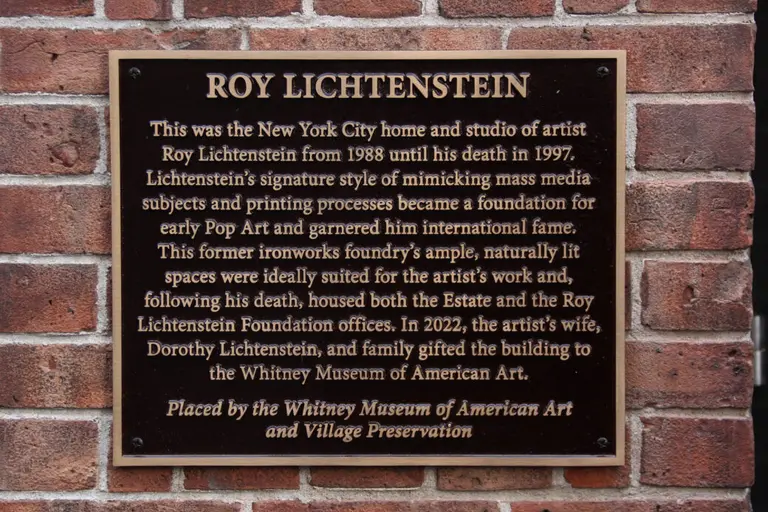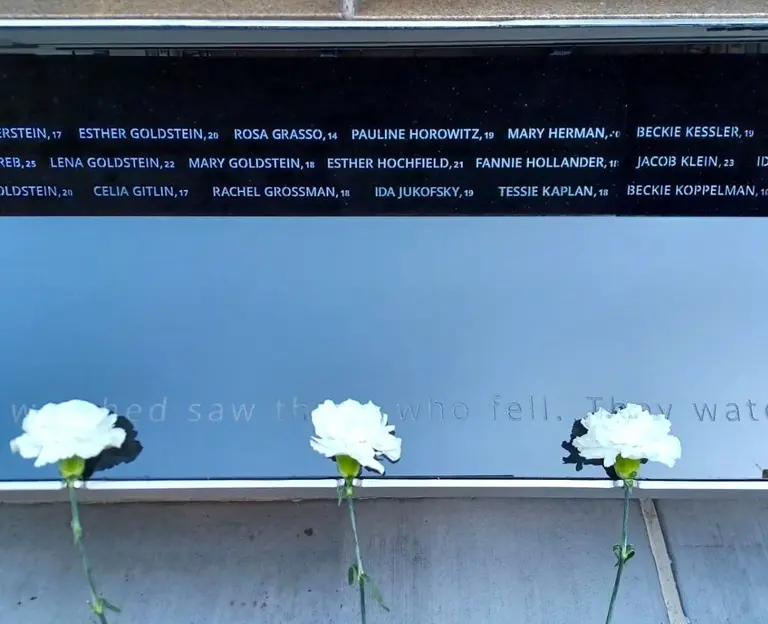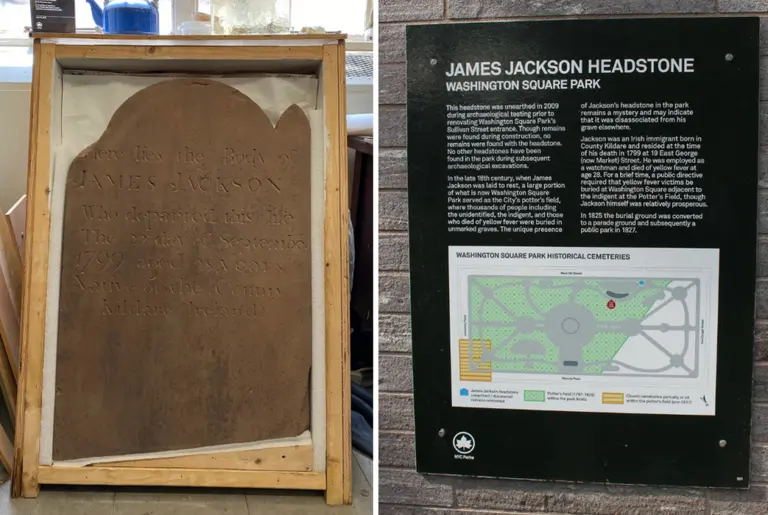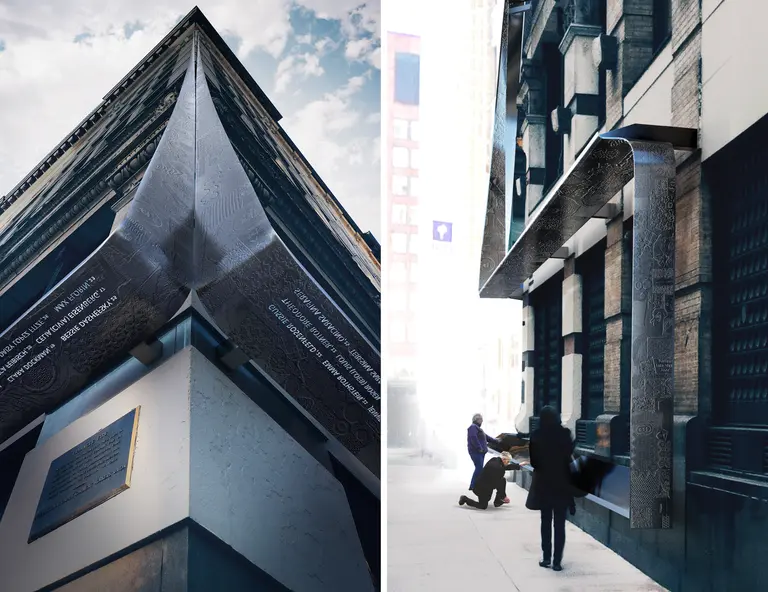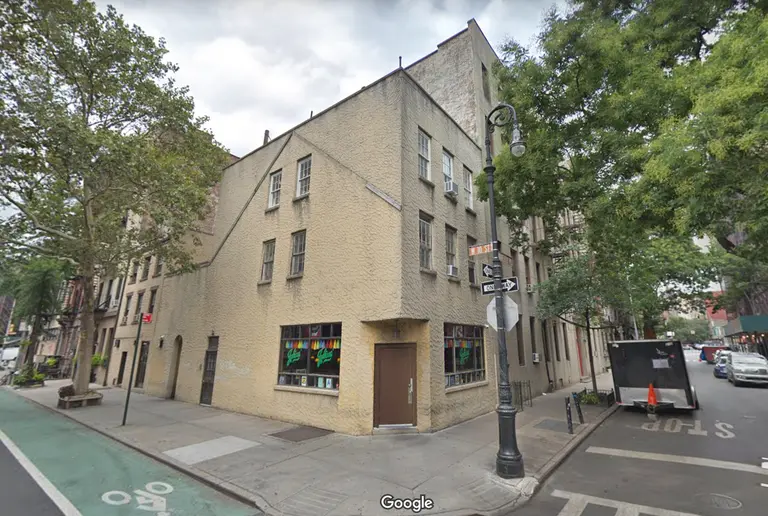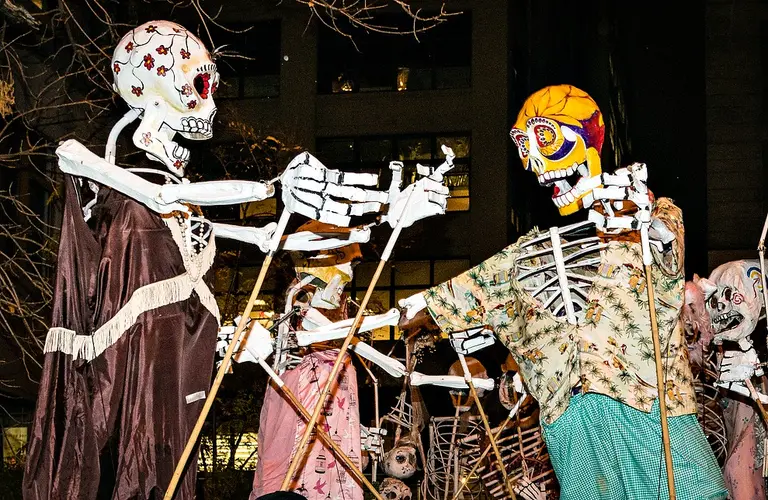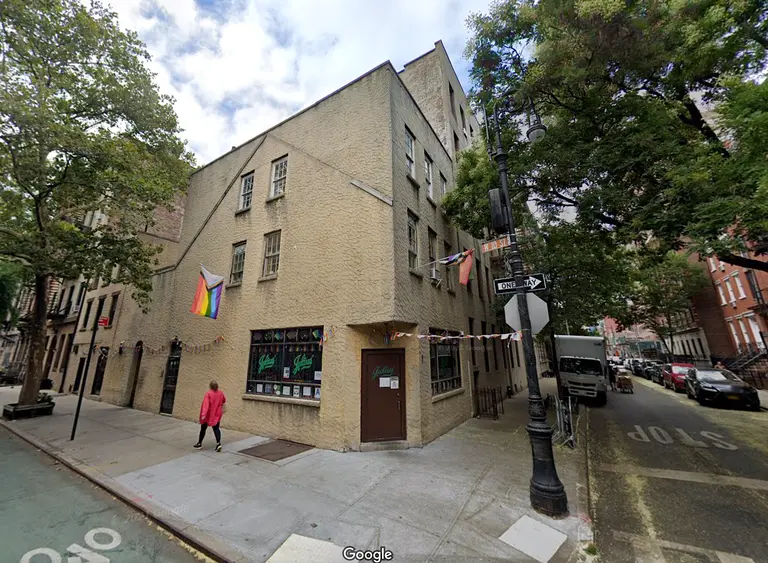The history of how the New York Public Library got its start Downtown
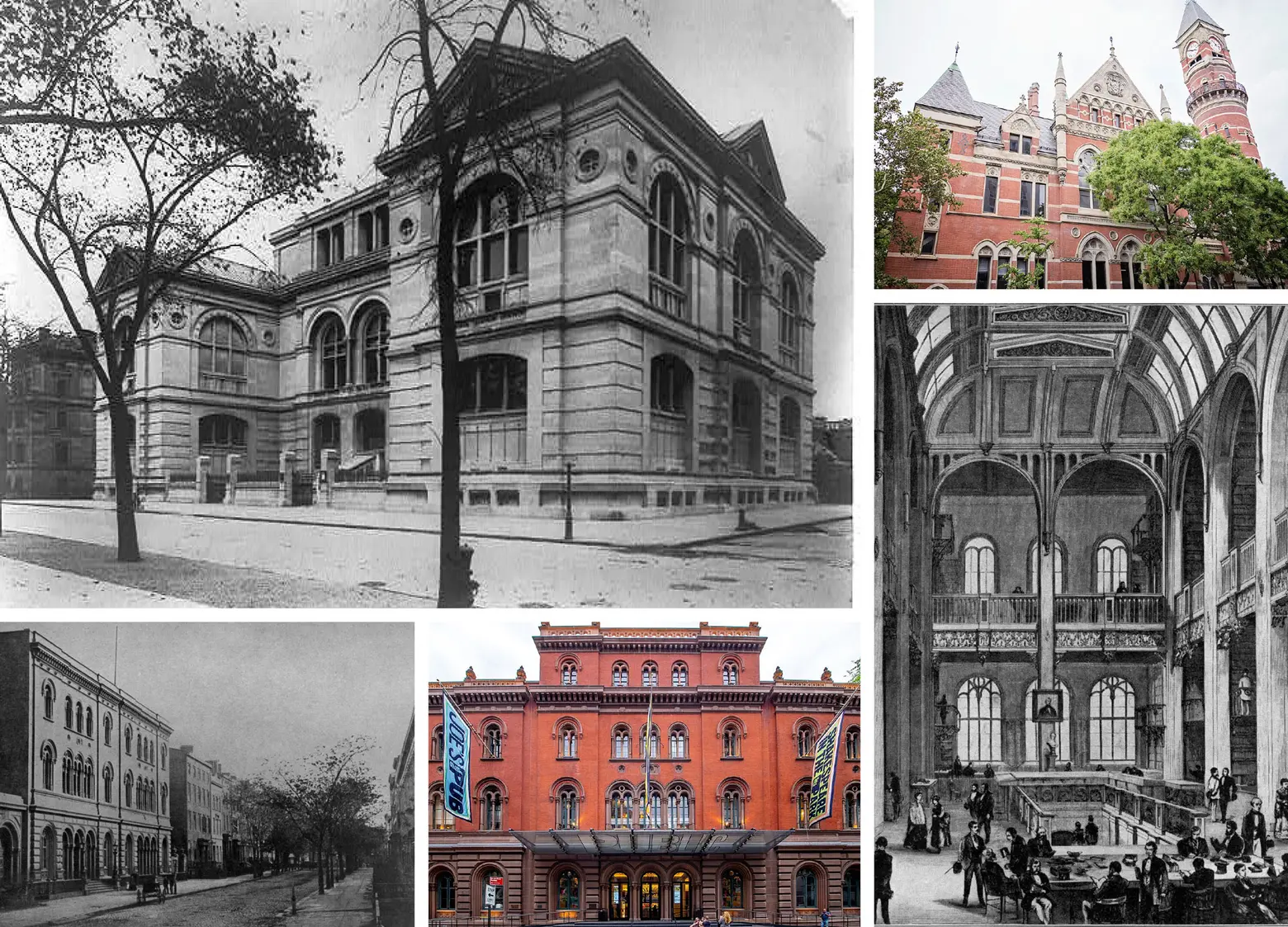
This year, the New York Public Library is celebrating its 125th anniversary. With 53 million items and 92 locations across Manhattan, the Bronx, and Staten Island, the NYPL is the largest municipal library in the world. It’s also the steward of some of New York’s greatest landmarks, reflecting a century and a quarter of Gotham’s history, and in some cases even more.
The roots of this library system can be found in Greenwich Village, the East Village, and Noho. The main antecedents of the NYPL which formed the foundation of today’s system— the Astor Library, the Lenox Library, and the New York Free Circulating Library – all began in these neighborhoods just below 14th Street. As a result, this is where New York’s oldest public library buildings and the oldest building housing an NYPL branch are located — the latter ironically having been where great works of literature were banned and censored before it became a library.
The Astor Library
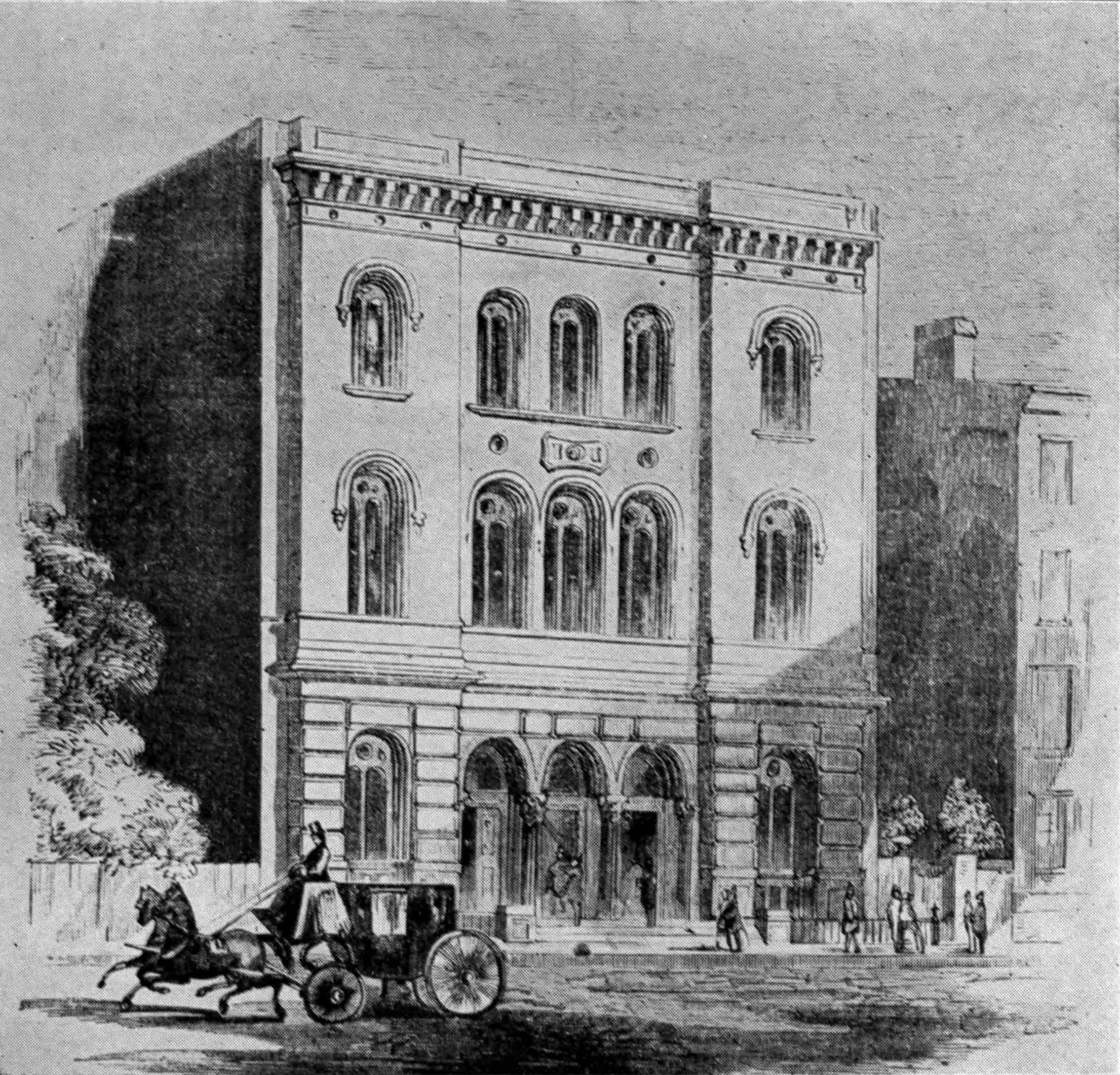 The Astor Library on Lafayette Street in 1854, via Wikimedia Commons
The Astor Library on Lafayette Street in 1854, via Wikimedia Commons
The Astor Library was established in 1848 as a private reference or non-circulating library open to the public. Founded by the German-born American fur merchant and real estate tycoon John Jacob Astor, it was originally located in a house at 32 Bond Street in NoHo, long-since demolished and replaced by the Herzog and de Mueron-designed 40 Bond Street. But that was only a temporary location (1849-1853) while a grand home was built for the library on the east side of what was then known as Lafayette Place (now Lafayette Street), just south of Astor Place.
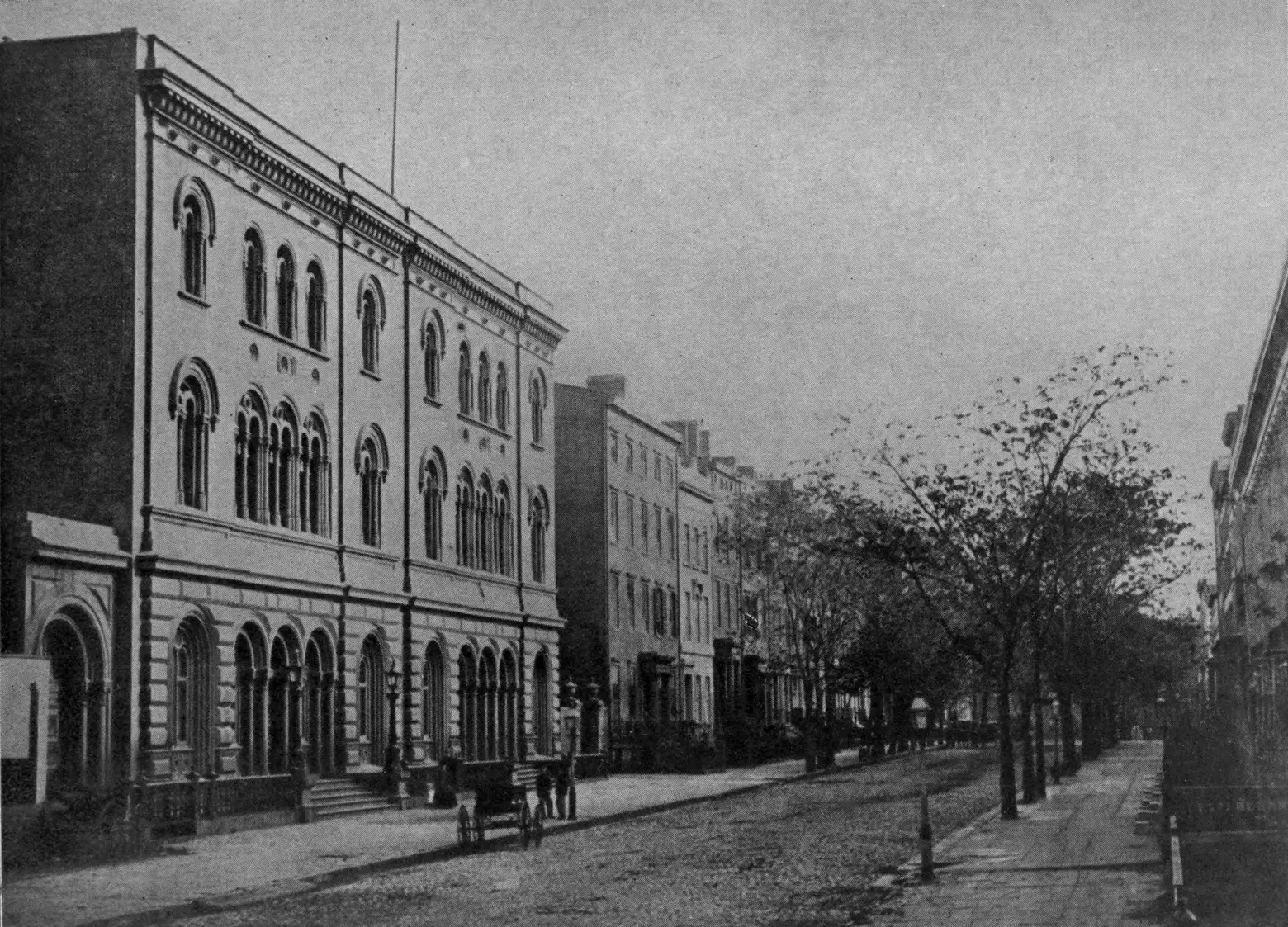 Top: Astor Library in 1870, via Wikimedia Commons; Bottom: The library’s south hall in 1875, via Wikimedia Commons
Top: Astor Library in 1870, via Wikimedia Commons; Bottom: The library’s south hall in 1875, via Wikimedia Commons
The Astor Library opened in 1854 in its new permanent home with 80,000 volumes and the great writer Washington Irving as its superintendent. Designed in the Rundbogenstil (German for “round style,” it was a combination of the Byzantine, Romanesque, and Renaissance styles popular in Germany and in the German diaspora in the 19th century), the choice reflected Astor’s German roots. The library grew rapidly, with one extension added to the north of the building in 1859 and a second in 1881. By 1890, the private library had 260,000 volumes and was by far the largest in the New York metropolitan area. But it was also facing considerable financial challenges. In 1894, the Astor Library began negotiations to combine resources with the rival Lenox Library and the Tilden Trust*, a charity endowed to fund and create a library to serve the public, but which was never actually able to do so on its own. In 1895, the three institutions formally merged, forming the New York Public Library.
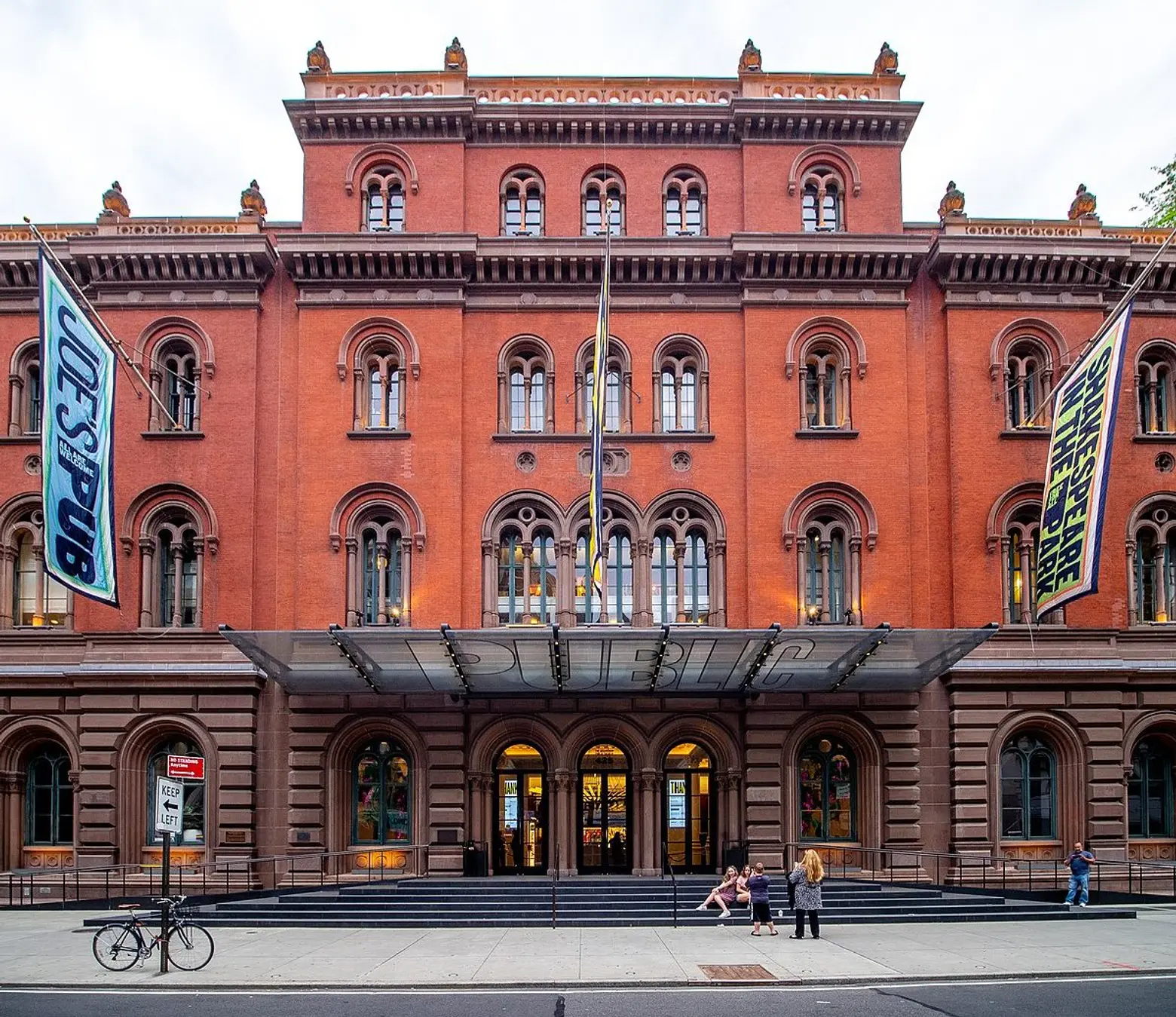 The Public Theater today, photo by Ajay Suresh via Wikimedia Commons
The Public Theater today, photo by Ajay Suresh via Wikimedia Commons
The Astor Library remained the new system’s flagship branch until a grand new central library opened on 42nd Street in 1911, and the Astor Library Branch finally closed its doors to the public. The grand building was taken over by the Hebrew Immigrant Aid Society, which remained there for about four decades. The historic building then lay fallow and was slated for demolition when in one of the seminal preservation battles of the 1960s it was saved and repurposed as a permanent home for Joseph Papp’s Public Theatre, which remains there to this day.
The Lenox Library
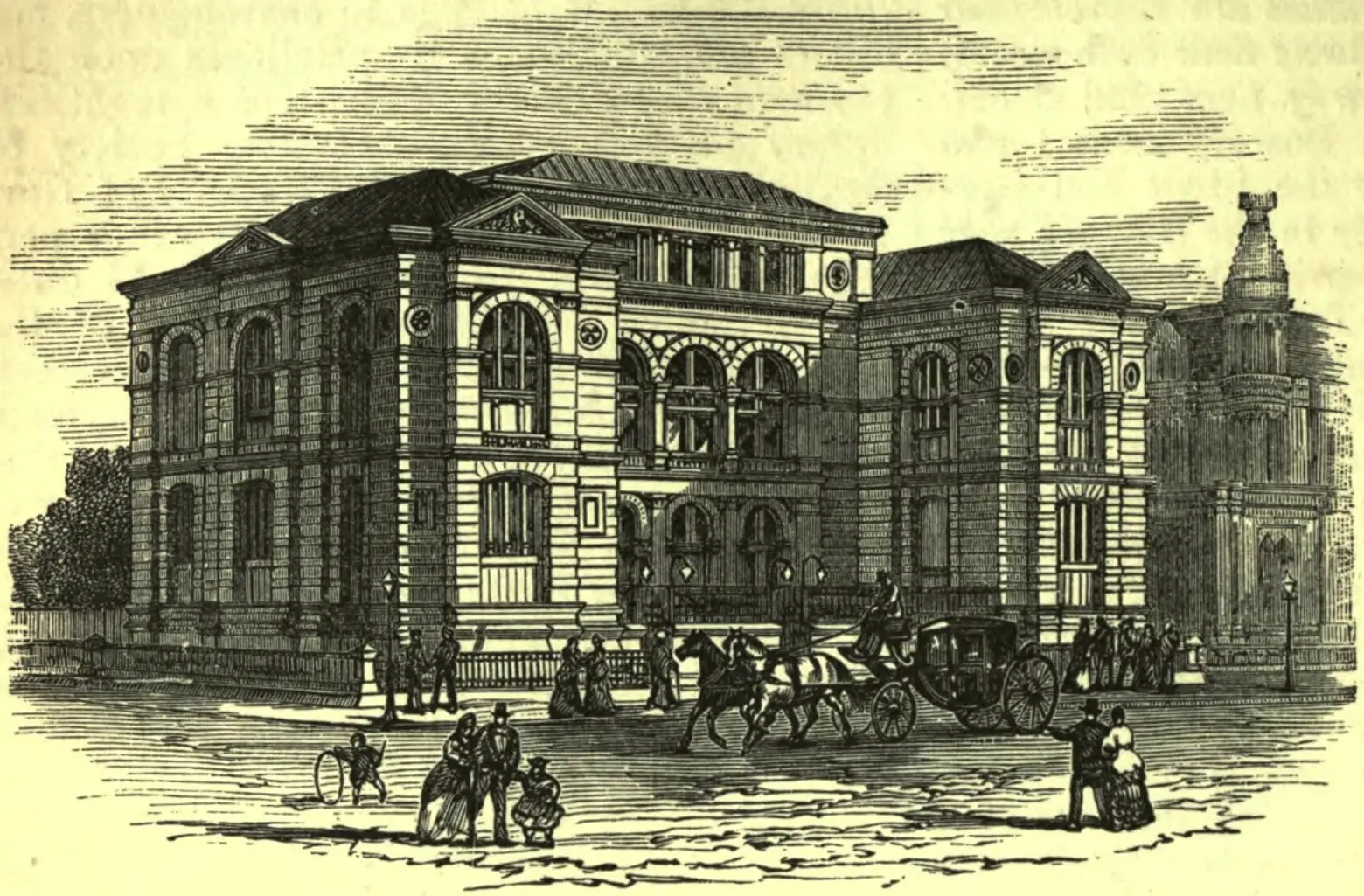 The Lenox Library in 1879, via Wikimedia Commons
The Lenox Library in 1879, via Wikimedia Commons
The Lenox Library was the product of eccentric Gilded Age millionaire James Lenox. His father Robert, a Scottish immigrant, became one of the most successful real estate investors and developers in New York City in the early 19th century and one of its richest men. When he died in 1839, James inherited the family business, as well as 300 acres of property on today’s Upper East Side (the neighborhood now known as Lenox Hill). But by 1845, James Lenox was done with business and retired to pursue his passions of book collecting and building an unrivaled home for himself.
He succeeded wildly in both endeavors. Lenox quickly amassed one of the largest book collections in the country, with a special emphasis on rare books, Americana, and an unsurpassed collection of bibles, including the only Guttenberg Bible in America. Starting in 1846, he also built one of the largest and most impressive homes in 19th-century New York, what came to be known as the Lenox Mansion, on the northeast corner of Fifth Avenue at 12th Street. It was located diagonally across from the First Presbyterian Church to which the deeply religious Lenox was extremely dedicated and on the newly fashionable lower Fifth Avenue which just a few years earlier Henry Brevoort had turned into New York’s premier address with the construction of his mansion.
Lenox’s two passions came together when he turned his home into a repository for his ever-growing book collection. The library was, however, kept private, with only the notoriously reclusive Lenox knowing how the books were ordered and where they were kept. Visitors seeking to access the world-renowned private library– which included among other prized items George Washington’s farewell address, all known editions of Milton’s Paradise Lost, and several first editions of Shakespeare’s plays–were typically rebuffed. The rare exception was when New York’s chief Judge Charles P. Daly wished to see a book of which Lenox owned the only known copy in the country; Lenox had it sent to Daly with a servant, who was instructed to wait with it and the judge until he was done reading, and then immediately return with it.
Lenox was eventually convinced to move his extraordinary book collection to a location where it could be accessed, albeit on a limited basis, by the public. In 1877, his Lenox Library opened in a sumptuous Neo-Grec-style structure occupying the full blockfront of Fifth Avenue between 70th and 71st Streets facing Central Park, designed by one of the 19th century’s most renowned architects, Richard Morris Hunt. Located in the middle of Lenox’s 300 acres, the building was one of Gilded Age New York’s most striking landmarks. Housing 85,000 items, the library and its galleries were a must-see for scholars and elites, who had to apply or pay for admission.
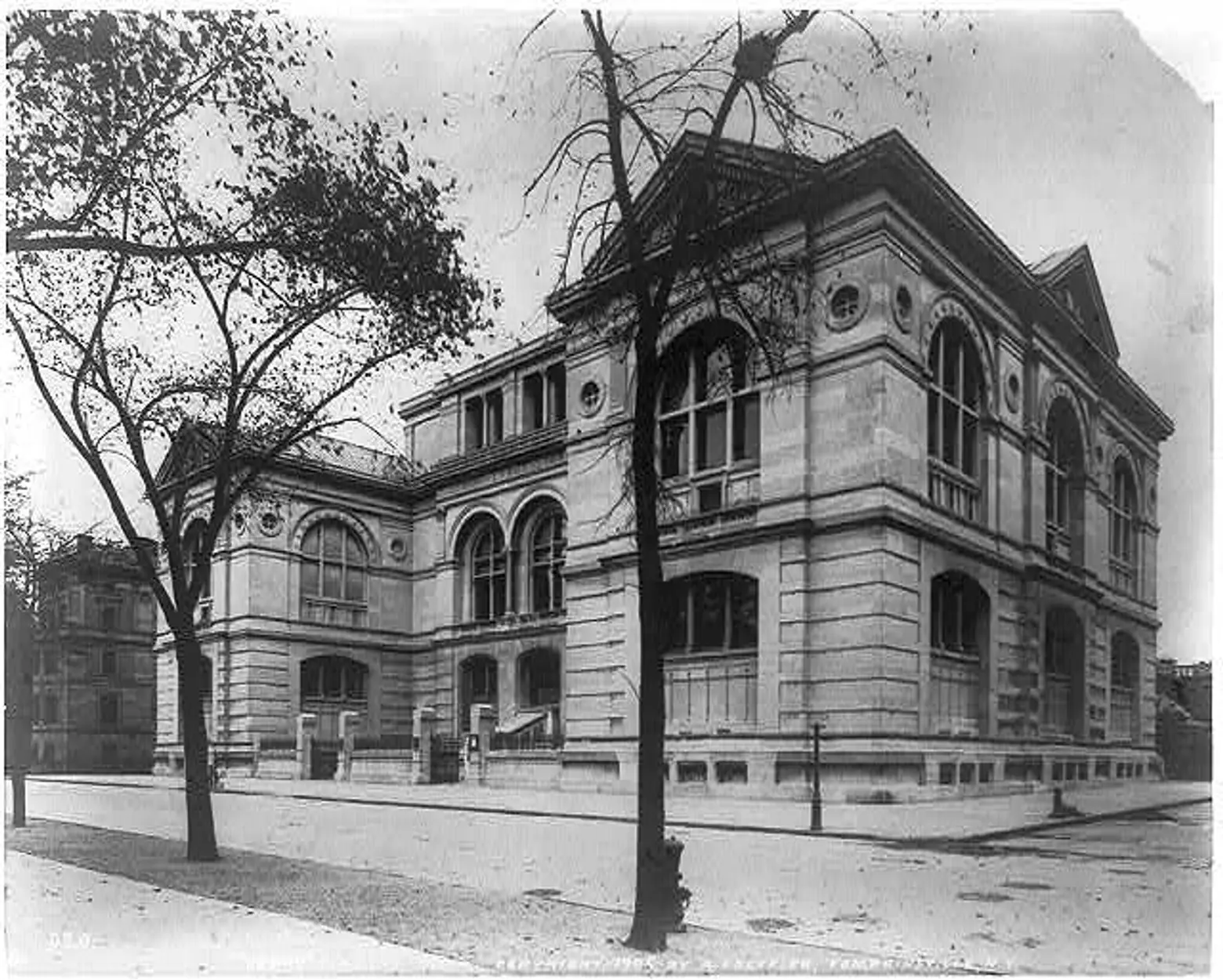 The Lenox Library in 1905, via Library of Congress
The Lenox Library in 1905, via Library of Congress
Lenox died in 1880 just after his library opened, and its finances immediately began to suffer. With the Astor Library facing similar challenges and the newly-established Tilden Trust ready to fund a public library, the three merged in 1895. The Lenox Library at 70th Street remained in operation until the new main branch of the NYPL opened on 42nd Street in 1911, and all its books were transferred there. Lenox’s imposing Upper East Side landmark was demolished in 1912, just 35 years after it opened, replaced by Henry Clay Frick’s mansion, now the Frick Museum.
The New York Free Circulating Library
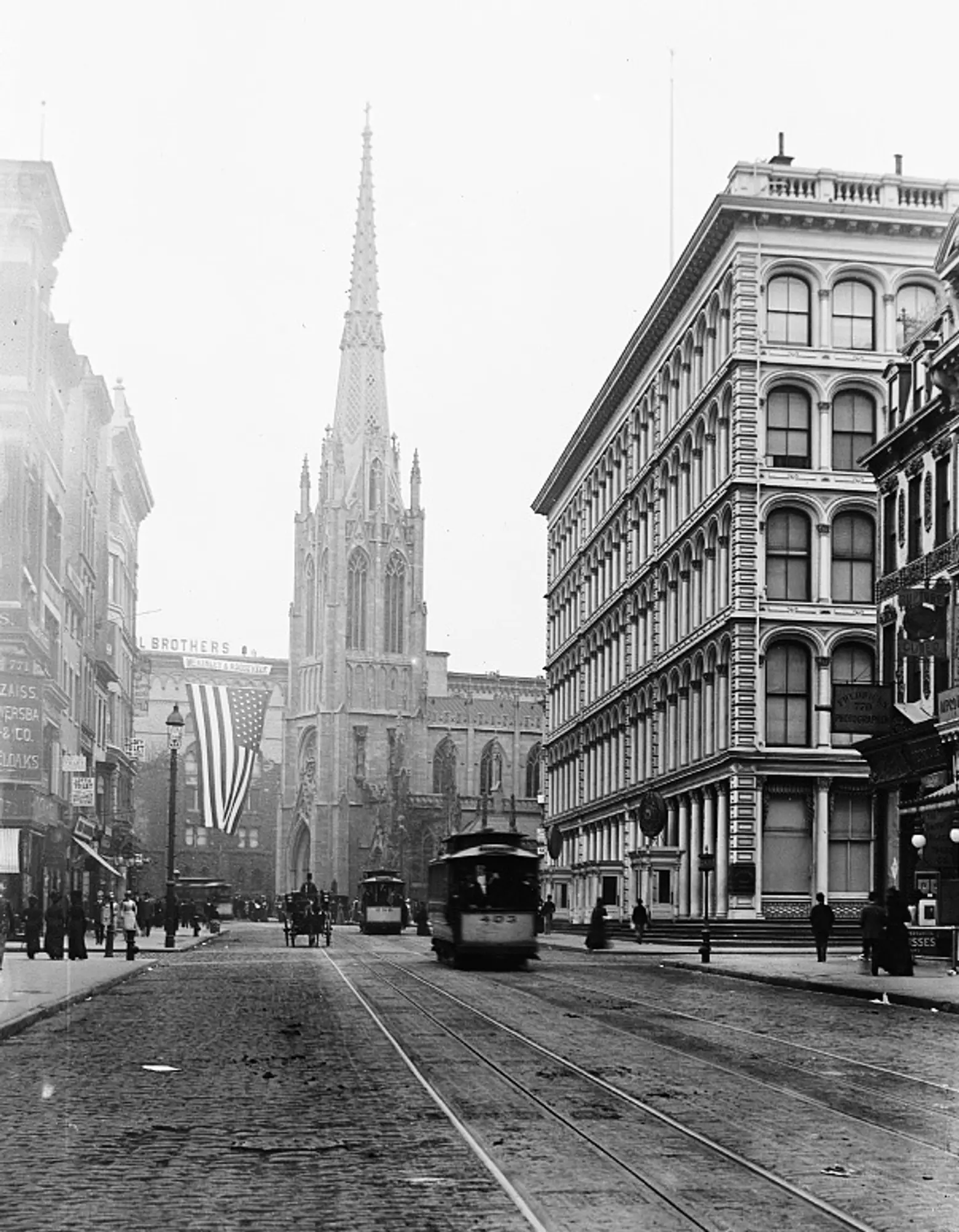 Looking up Broadway to Grace Church in 1900, via Wikimedia Commons
Looking up Broadway to Grace Church in 1900, via Wikimedia Commons
The Astor Library may have been New York’s largest library in the 19th century, but as it was only open during daytime hours and did not lend or circulate books, its utility to the average New Yorker was limited and tended to serve a more well-heeled population. The Lenox Library served an even more elite and narrow slice of the public.
By contrast, the New York Free Circulating Library was established to serve every New Yorker, especially the poor, and to allow them to not only read a wide range of literature but bring it home and share it with their families. New York’s very first free circulating library began in a sewing class at Greenwich Village’s Grace Church (Broadway and 11th Street), where a teacher sought to provide her students with substantive reading material rather than the ubiquitous sensational tabloids which frequently occupied them.
What would become the New York Free Circulating Library (NYFCL) was started in 1879 by the Grace Church teacher and a coterie of other women and teachers as a reading room in a building on 13th Street just east of Fourth Avenue in the East Village. Though initially open only two hours a week and containing only 500 books, the free public reading room was so popular there were often lines around the block, and as few as two books were left at the end of a session.
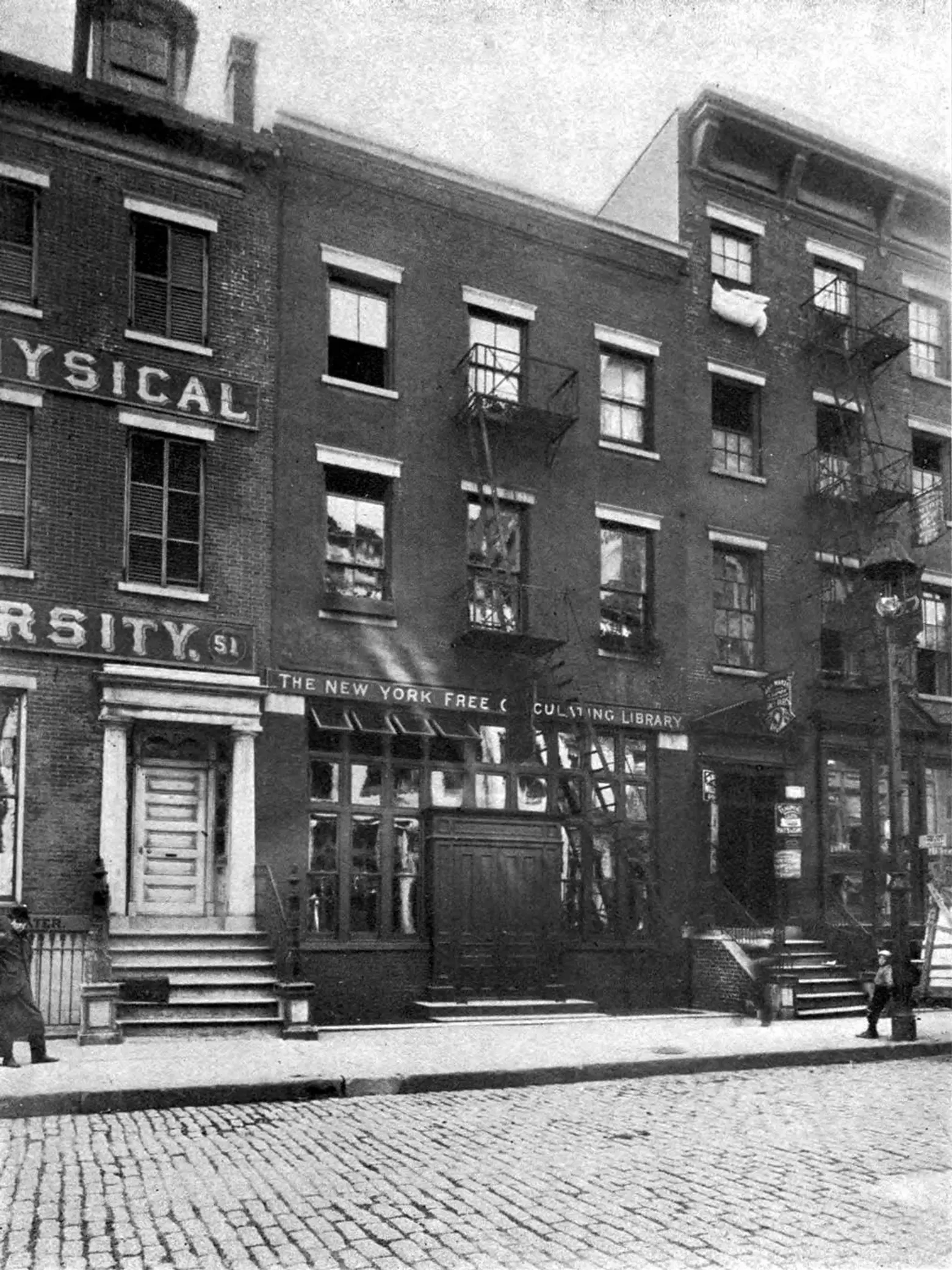 49 Bond Street, via Wikimedia Commons
49 Bond Street, via Wikimedia Commons
Within a year, the library’s collection increased to 1,200 volumes purely from donations, and patrons ranged from children to 70-year-old men. Seeing the great need, the New York Free Circulating Library was incorporated in 1880 and moved to two rented rooms in a house at 36 Bond Street in NoHo (coincidentally just two doors east of the Astor Library’s original temporary home at 32 Bond Street, and like that building long-since demolished and replaced by the starchitect-designed 40 Bond).
With increasing demand and growing support from government and business, in 1883, the NYFCL was able to purchase its first building, an early 19th-century house just down the block at 49 Bond Street. That house still stands today, between Lafayette Street and the Bowery, protected by the NoHo Historic District, though it has not served as a library for over a century.
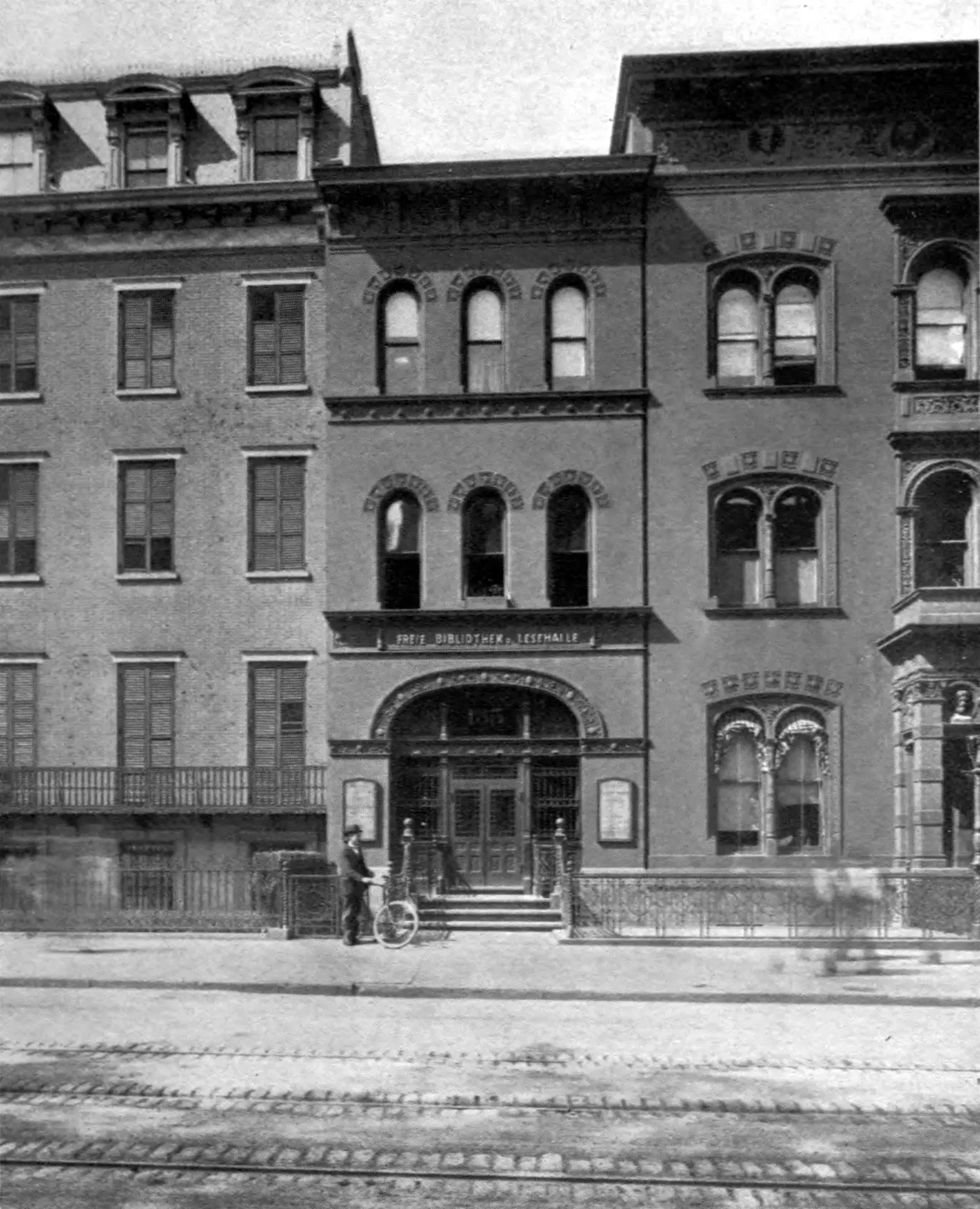 The Ottendorfer Branch in 1884, via Wikimedia Commons
The Ottendorfer Branch in 1884, via Wikimedia Commons
The NYFCL’s next great leap forward was the construction of its first purpose-built library, New York’s first-ever building constructed as a free circulating public library.
In 1884, German-American newspaper editor Oswalt Ottendorfer built and donated a branch library to the NYFCL at 135 Second Avenue containing 8,000 volumes. Half were in German and half were in English, as it was intended to serve the surrounding Kleindeutschland neighborhood, which was then the largest German-speaking community in the world outside of Berlin and Vienna. Named the Ottendorfer Branch by the NYCFL for its benefactor, the red brick and terra cotta building, built in conjunction with the adjacent German Dispensary, served the local German immigrant population until their dispersal from the East Village in the early 20th century.
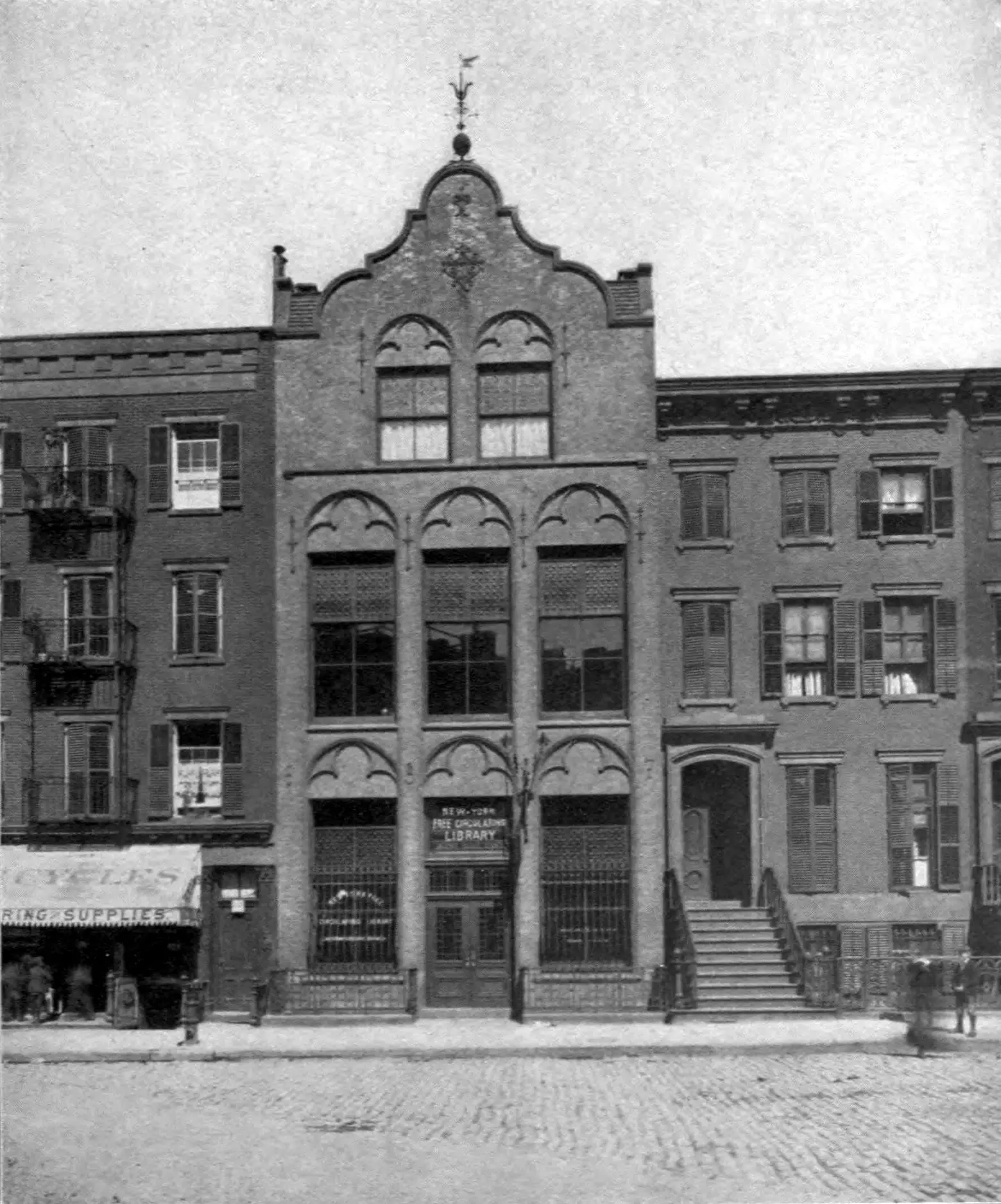 The Jackson Square Branch in 1890, via Wikimedia Commons
The Jackson Square Branch in 1890, via Wikimedia Commons
In 1888, the NYFCL expanded with two new branches, one no longer extant at 226 West 42nd Street and the spectacular Jackson Square Branch at 251 West 13th Street (Greenwich/8th Avenue), which still stands today. The building, land, and books were the gift of George Washington Vanderbilt II, perhaps best known for building the 250-room Biltmore Estate in North Carolina, the largest home in the United States. Like the Lenox Library, the Jackson Square Library’s Flemish gable design was also the product of legendary 19th-century architect Richard Morris Hunt, who modeled the building upon a Dutch guildhall. It was one of the very first libraries to introduce the innovation of open stacks, where the public could actually pick books off the shelves themselves, rather than having to find a card number in a catalog and ask a librarian to retrieve the book for them (which was considered essential by libraries to avoid theft).
The building continued to operate as a library until it was decommissioned in the early 1960s and slated for demolition. But in 1967, it was acquired by the avant-garde painter, sculptor, and performance artist Robert Delford Brown for his First National Church of the Exquisite Panic. The building passed hands to the television producer Tom Fontana in 1995, who lives and has his offices there to this day.
While the New York Free Circulating Library continued to grow, by the beginning of the new century they were in merger negotiations with the newly-formed New York Public Library. In 1901, their 11 branches, including Bond Street, Ottendorfer, and Jackson Square, containing 1.6 million volumes, were absorbed into the NYPL, significantly increasing the breadth and reach of the public library system.
Jefferson Market Library
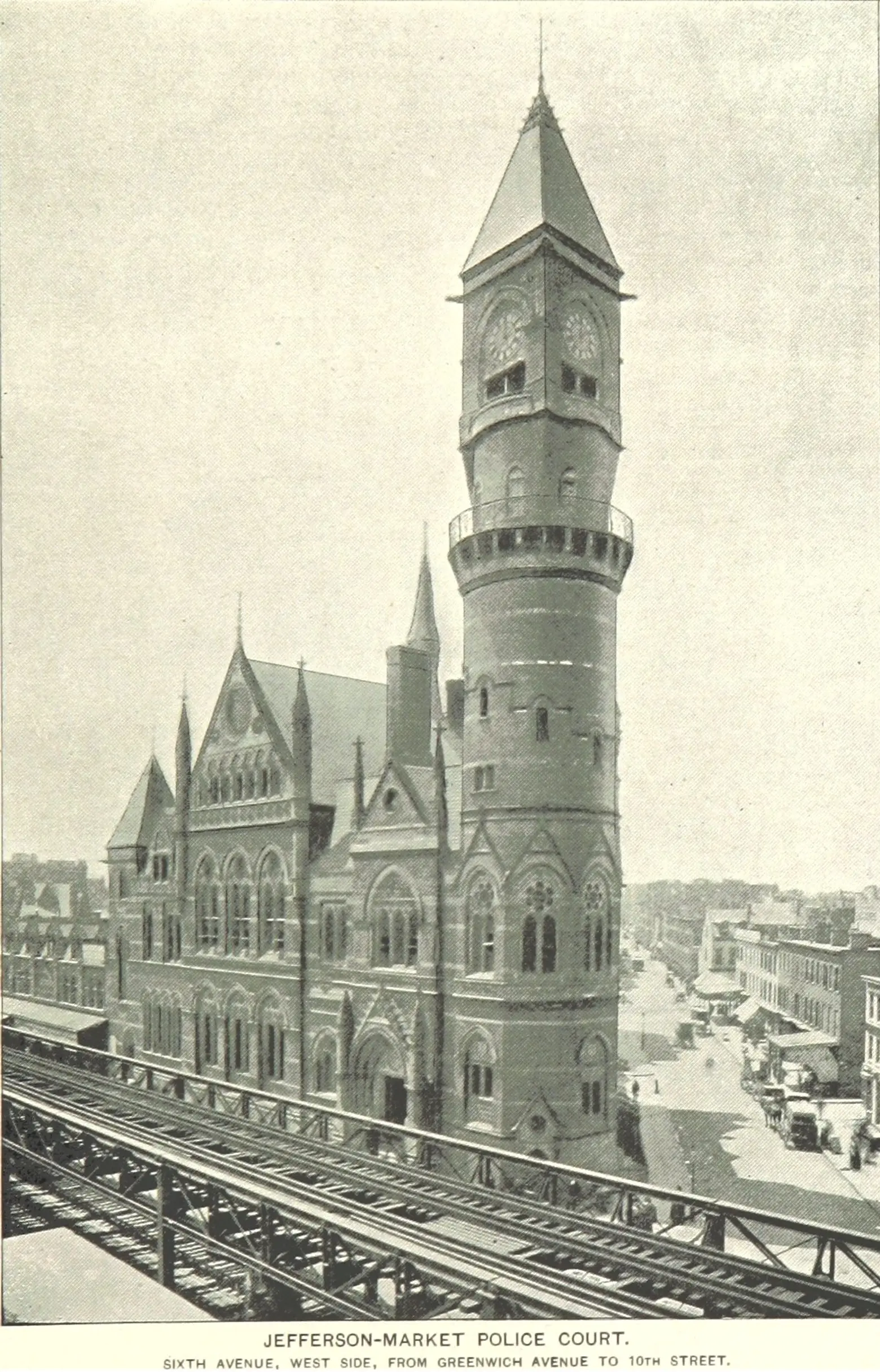 The Jefferson Market Courthouse in 1893, via Wikimedia Commons
The Jefferson Market Courthouse in 1893, via Wikimedia Commons
One of the newer NYPL branches is actually the oldest building in the system. Today’s Jefferson Market Library at 425 Sixth Avenue (10th Street) was built in 1877 by architects Frederick Clark Withers and Calvert Vaux in the Victorian Gothic style and was immediately declared one of the 10 most beautiful buildings in America by the leading architects of the day. It was not built as a library, however, but rather a courthouse covering some of the rowdiest and most crime-ridden blocks in New York of its day. This did not mean the courthouse never intersected with great authors. In 1896, Greenwich Village resident Stephen Crane, author of “The Red Badge of Courage,” testified in the courthouse on behalf of a woman he claimed was unjustly arrested for prostitution. Crane claimed that he was “studying human nature” in the Tenderloin district when the alleged solicitation took place. Front-page headlines the following day applauded Crane’s “chivalry and courage” for defending the woman’s virtue.
 The Jefferson Market Courthouse building in 1935, courtesy of The Miriam and Ira D. Wallach Division of Art, Prints and Photographs: Photography Collection, The New York Public Library
The Jefferson Market Courthouse building in 1935, courtesy of The Miriam and Ira D. Wallach Division of Art, Prints and Photographs: Photography Collection, The New York Public Library
As the 20th century began and the district it covered (which stretched to Times Square) contained an ever-increasing number of theaters, publishing houses, and performance venues, including decidedly left-of-center ones, the Jefferson Market Courthouse saw a growing number of cases involving “obscenity” and censorship. One of the most notorious involved a 1921 case in which Margaret Anderson and Jane Heap, publishers of the small avant-garde Greenwich Village literary magazine “The Little Review,” were hauled into court and convicted of obscenity for publishing excerpts of James Joyce’s banned book “Ulysses.” Another occurred just six years later when Mae West was brought in and sentenced to 10 days in jail for “corrupting the morals of youth” with her play “Sex.”
By 1945, the building was no longer needed as a courthouse, and after being used by the Police Department for several years, it was left abandoned. Slated for demolition, Villagers rallied to save the building, proposing to convert it to a much-needed larger local library (the area was at the time still served by the elegant but tiny Jackson Square Library). The city finally agreed, and the building was rededicated as an NYPL branch in 1967, leading to the decommissioning of the Jackson Square branch.
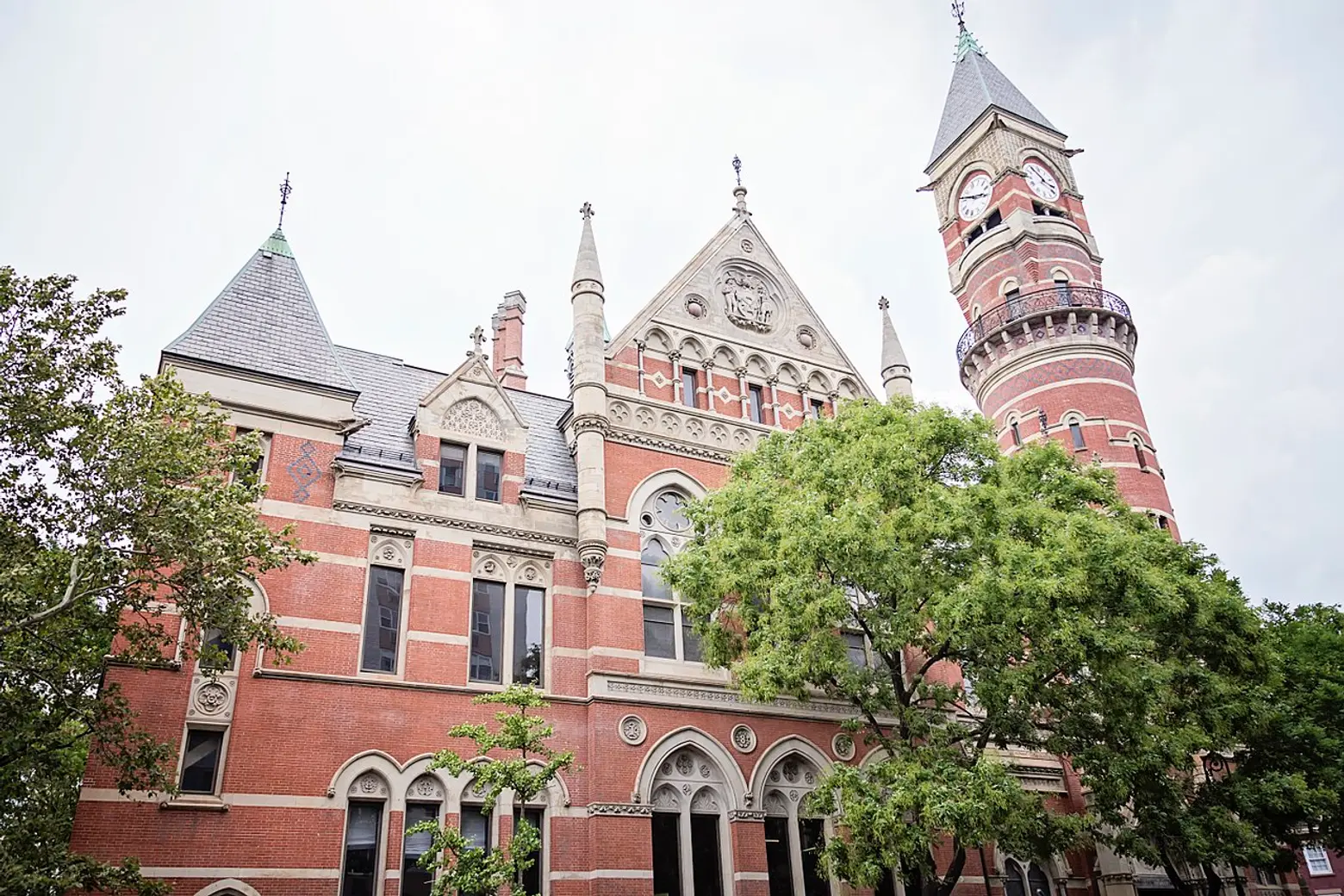 The Jefferson Market Library today, via Wikimedia Commons
The Jefferson Market Library today, via Wikimedia Commons
The Jefferson Market Library continues to operate here more than 50 years later. Housed in a building that predates the establishment of the NYPL by 18 years and the New York Free Circulating Library by three, it’s now the oldest library building in the NYPL system. What was once a civil court on the second floor is now the Adult Reading Room; a police court on the first floor now functions as the Children’s Room; and the striking brick-arched basement, formerly used as a holding area for prisoners on their way to jail or trial, now serves as the Reference Room. And where works by or about James Joyce or Mae West were once censored, they are now circulated for free to the public.
* Of the main components of the New York Public Library, the Tilden Trust’s connections to Greenwich Village, the East Village, and NoHo are the most tenuous. However, the Trust was created by the former NY Governor and only Presidential candidate to win an outright majority of the popular vote and yet lose the election, Samuel J. Tilden. Tilden began his political career by earning his law degree at New York University in Greenwich Village.
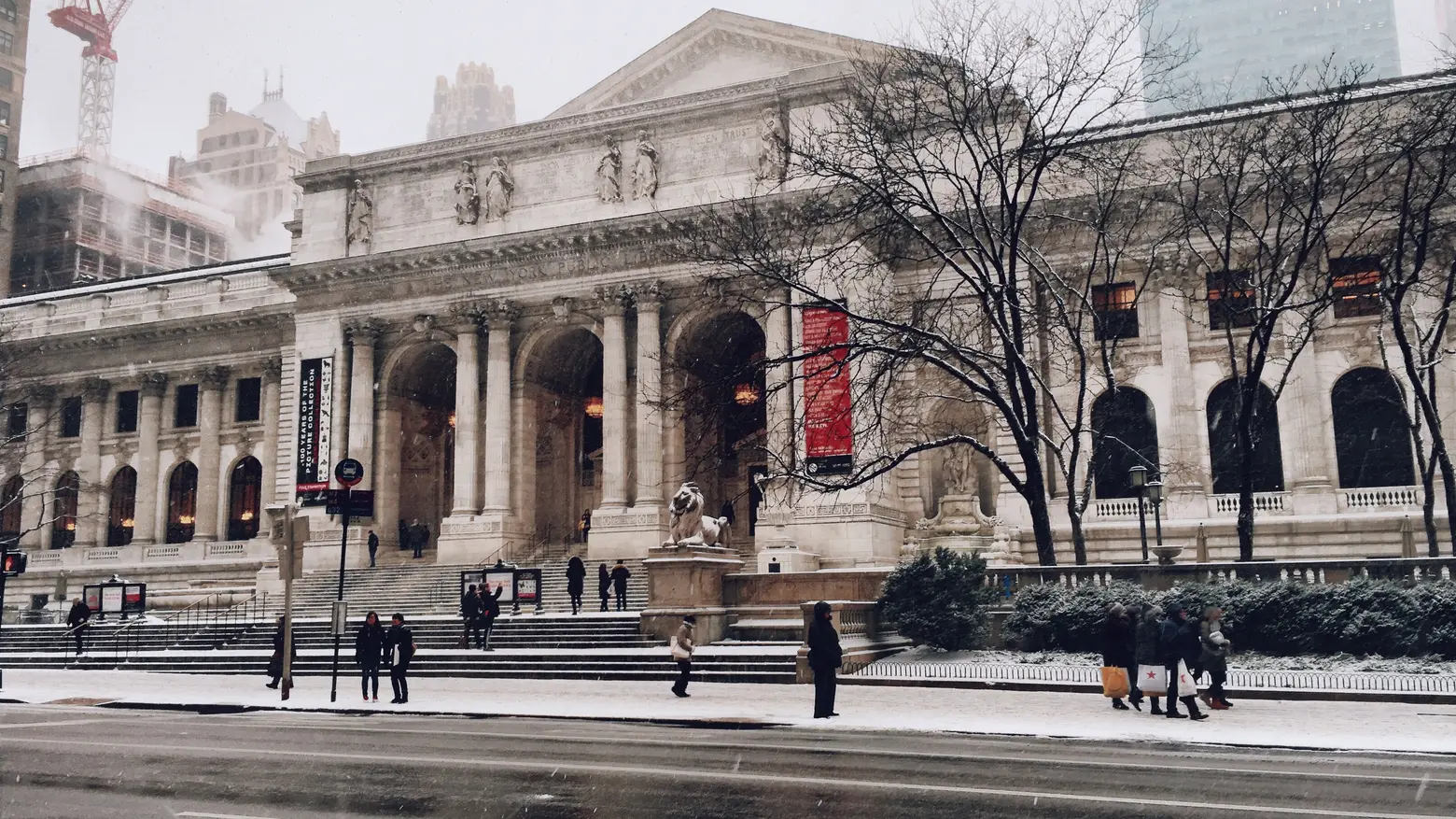 The New York Public Library’s main branch today, Photo by Jon Tyson on Unsplash
The New York Public Library’s main branch today, Photo by Jon Tyson on Unsplash
RELATED:
